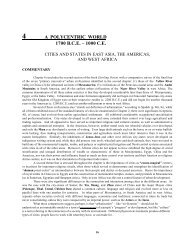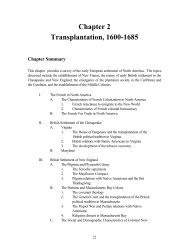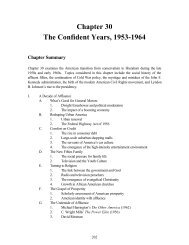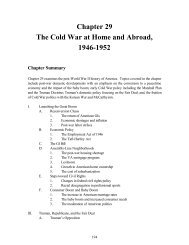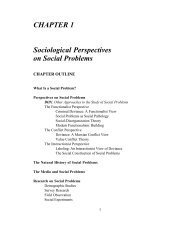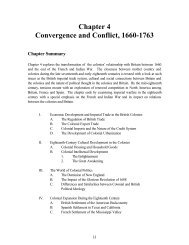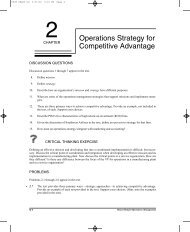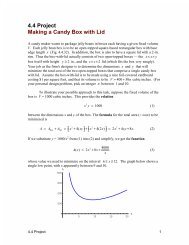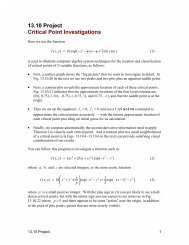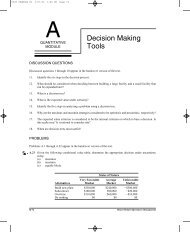Merchandising Operations and the Accounting Cycle - Pearson
Merchandising Operations and the Accounting Cycle - Pearson
Merchandising Operations and the Accounting Cycle - Pearson
You also want an ePaper? Increase the reach of your titles
YUMPU automatically turns print PDFs into web optimized ePapers that Google loves.
AUSTIN SOUND CENTRE INC.<br />
Trial Balance<br />
December 31, 2004<br />
Cash ...................................................................................... $ 2,850<br />
Accounts receivable ........................................................... 4,600<br />
Note receivable, current .................................................... 8,000<br />
Interest receivable ...............................................................<br />
Inventory ............................................................................. 38,600<br />
Supplies ............................................................................... 650<br />
Prepaid insurance .............................................................. 1,200<br />
Furniture .............................................................................. 33,200<br />
Accumulated amortization—furniture ........................... $ 2,400<br />
Accounts payable ............................................................... 47,000<br />
Unearned sales revenue .................................................... 2,000<br />
Wages payable .....................................................................<br />
Interest payable ...................................................................<br />
Note payable, long-term ................................................... 12,600<br />
Common stock..................................................................... 10,000<br />
Retained earnings................................................................ 15,900<br />
Dividends ............................................................................ 54,100<br />
Sales revenue ...................................................................... 168,000<br />
Sales discounts .................................................................... 1,400<br />
Sales returns <strong>and</strong> allowances ............................................ 2,000<br />
Interest revenue .................................................................. 600<br />
Purchases ............................................................................ 91,400<br />
Purchase discounts ............................................................ 3,000<br />
Purchase returns <strong>and</strong> allowances.................................... 1,200<br />
Freight in ............................................................................. 5,200<br />
Amortization expense—furniture ...................................<br />
Insurance expense...............................................................<br />
Interest expense .................................................................. 1,300<br />
Rent expense ....................................................................... 8,400<br />
Supplies expense .................................................................<br />
Wages expense .................................................................... 9,800<br />
Total ...................................................................................... $262,700 $262,700<br />
Additional data at December 31, 2004:<br />
a. Interest revenue earned but not yet collected, $400.<br />
b. Supplies on h<strong>and</strong>, $100.<br />
c. Prepaid insurance expired during <strong>the</strong> year, $1,000.<br />
d. Amortization for <strong>the</strong> year, $600.<br />
e. Unearned sales revenue earned during <strong>the</strong> year, $1,300.<br />
f. Accrued wage expense, $400.<br />
g. Accrued interest expense, $200.<br />
h. Inventory on h<strong>and</strong> based on inventory count, $40,200.<br />
beginning inventory in computing cost of goods sold. Placing ending inventory ($40,200)<br />
in <strong>the</strong> credit column decreases cost of goods sold.<br />
Purchases <strong>and</strong> Freight In appear in <strong>the</strong> debit column because <strong>the</strong>y are added in<br />
computing cost of goods sold. Purchase Discounts <strong>and</strong> Purchase Returns <strong>and</strong><br />
Allowances appear as credits because <strong>the</strong>y are subtracted in computing cost of<br />
goods sold—$90,800 on <strong>the</strong> income statement in Exhibit 5S-6 on page 285.<br />
The income statement column subtotals on <strong>the</strong> work sheet indicate whe<strong>the</strong>r<br />
<strong>the</strong> business earned net income or incurred a net loss. If total credits are greater,<br />
<strong>the</strong> result is net income, as shown in Exhibit 5S-5. If total debits are greater, a net<br />
loss has occurred.<br />
EXHIBIT 5S-4<br />
Trial Balance<br />
Chapter Five <strong>Merch<strong>and</strong>ising</strong> <strong>Operations</strong> <strong>and</strong> <strong>the</strong> <strong>Accounting</strong> <strong>Cycle</strong> 283



